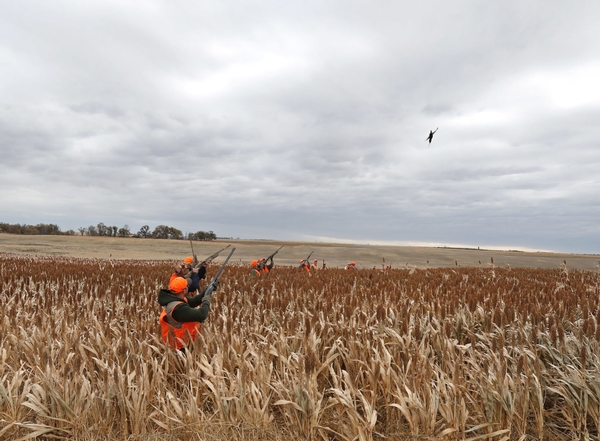Some Farmers Optimistic About Pheasant Numbers
August 14, 2018 by Shannon Marvel - Aberdeen News

Results from the state’s annual pheasant brood count survey are expected by the end of the month, but some local landowners are already optimistic.
Aberdeen area farmer Kirk Schaunaman said he expects the pheasant count numbers to be better than past years.
“I would say they are better than what they are last year, or probably the last two years southwest of town, but not like it was 10 years ago, but certainly better than it was the last couple of years. It’s better, let’s put it that way. The chicks are moving now, you’re starting to see them more,” Schaunaman said.
Pheasant hunting season in South Dakota begins Oct. 20; resident-only season is Oct. 13-15.
Brown County landowner and farmer Dennis Jones described the pheasant numbers this year as an “explosion.”
“Last year where hens were just having two or three, but they’re having 12 to 14 little chicks this year,” Jones said. “So many more broods, too. The brood count is up. I’ve been out trimming around CRP with a mower for the Canadian thistle and I really see them when I’m out doing that.
“I’ve been up by Westport, Richmond Lake and the Bath and Columbia area. I’m seeing birds where there isn’t much habitat,” Jones said, adding that he’s even seen broods in the ditches. He surmises that some hens were able to hatch their broods in roadway ditches this year.
“Where there were 10 chicks last year, there would be 100 chicks this year,” Jones said.
Nick Cochran, a conservation officer with the state Game Fish and Parks Department for Brown County, said pheasant brood counts will continue until Wednesday.
“It’s really spotty this year again. Some areas got more rain than others across the state. In Brown County, we’ve been in a drought zone all summer, so in some places we’re seeing good numbers. I think we’re going to see better survival rates since we didn’t have those hot weeks consecutively like we did last year,” Cochran said.
But he was still cautious to speculate on the numbers in some areas within the region.
“The first round of some of the routes we ran weren’t up like we thought we’d see them. In other areas and doing some brood counts, we’re seeing some decent number of pheasants. In Brown County, it’s been spotty,” Cochran said.
The numbers last year were down 45 percent since 2016, 65 percent below the 10-year average statewide, and 78 percent below the 10-year average just in the Aberdeen region, according to the GFP’s annual survey from last year.
The statewide pheasants-per-mile index was at 1.68 last year, a decrease from 2016’s index of 3.05, according to the survey.
State Climatologist Laura Edwards echoed Cochran’s statements, saying that precipitation totals have varied throughout the region.
“Aberdeen is probably about the dividing line,” Edwards said. “If you’re west or southwest, it’s getting to be pretty right bad now, but if you’re east near Claremont or Groton, there’s more moisture, especially if you’re near Marshall County.
“But when you’re looking at pheasants, there are a few different factors, such as moisture to grow grass so they have habitat for protection. May was really dry and that sometimes (is) critical for some of the grasses,” she added.
The official pheasant survey count is expected to be released at the end of August.






